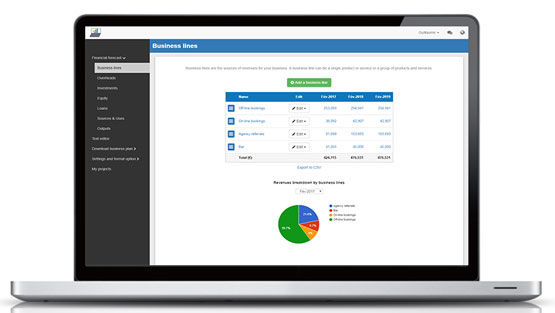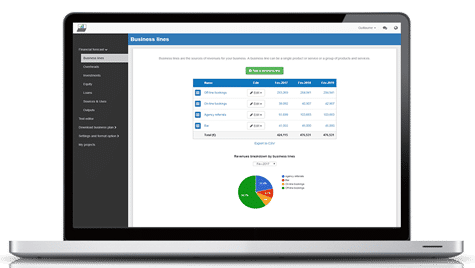How to open a panini shop?
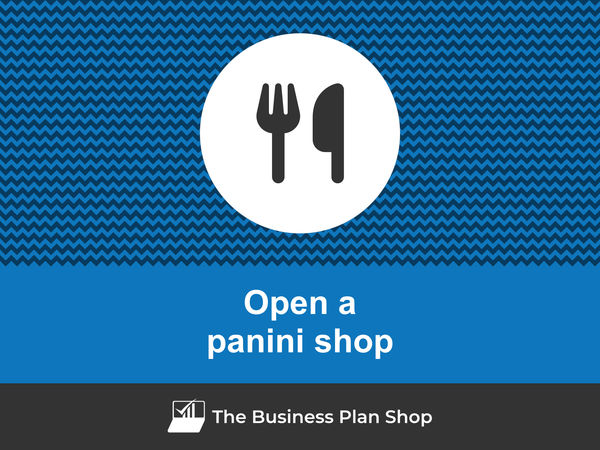
There's no doubt that starting a panini shop requires a lot of work, but with expert planning, you'll be well on your way to creating a profitable business venture.
This guide will give you a low down on all of the major steps involved, from choosing a legal structure to creating a financial forecast and registering your business.
We will also walk you through the process of checking whether or not your idea can be viable given market conditions.
Let's embark on this exciting journey together!
Learn how a panini shop works
Before you can start a panini shop, you need to have a solid understanding of how the business works and what are its main revenue streams.
This will give you a glimpse into the profitability potential of your venture, whilst allowing you to decide whether or not it is a good fit for your situation (current skill set, savings and capital available to start the business, and family responsibilities).
It may be that creating a panini shop is an excellent idea, but just not the right one for you.
Before starting their own company, successful entrepreneurs typically:
- Consult with and take advice from experienced panini shop owners
- Acquire hands-on experience by working in an operational panini shop
- Take relevant training courses
Let's explore each option in a bit more detail.
Consulting with and taking advice from experienced panini shop owners
Having "seen it all", established business owners can offer valuable insights and hands-on advice drawn from their own experiences.
This is because, through both successes and failures, they've gained a more informed and practical understanding of what it takes to build and sustain a successful panini shop over the long term.
Acquiring hands-on experience by working in an operational panini shop
If you want to open a panini shop, having industry-specific experience is imperative because it equips you with the knowledge, network, and acumen necessary to navigate challenges and make informed decisions critical to the success of your future business.
You'll also be able to judge whether or not this business idea is suitable for you or if there might be conflicts of interest with your personal life (for example, long working hours could be incompatible with raising young children).
This work experience will also help you to make contacts in the industry and familiarise yourself with customers and their expectations, which will prove invaluable when you set up your panini shop.
Take relevant training courses
Taking a training course is another way of familiarising yourself with the business model of your future activity before you decide to make the jump.
You may choose to complete a training course to obtain a certificate or degree, or just take online courses to acquire practical skills.
Before going any further in setting up your venture
Before you go any further with your plans to open a panini shop, make sure you have a clear vision of what it will take in terms of:
- What skills are needed to run the business successfully (do you have some or all of these skills?)
- What a standard working week looks like (does it suit your personal commitments?)
- What sales potential and long-term growth prospects the panini shop has (compare this with your level of ambition)
- What options you'll have once you decide to retire (or move on and inevitably sell the company)
This analysis of the business model and the constraints of the business should help you to check that your idea of launching a panini shop fits your entrepreneurial profile.
If there is a match, it will then be time to look at assembling the founding team of your business.
Assembling your panini shop's founding team
The next step to opening your panini shop is to think about the ideal founding team, or to decide to go in alone.
Starting and growing a successful business doesn't have to be a solo journey and setting up a panini shop with several co-founders is generally easier. The business benefits from a management team with a wider skillset, decisions are made together, and the financial risk is shared among the partners, making the journey more collaborative and less daunting.
But, running a business with several partners brings its own challenges. Disagreements between co-founders are quite common, and these can pose risks to the business. That's why it's crucial to consider all aspects before starting your own business.
We won't go into too much detail here, as this is a complex topic that deserves its own guide, but we do recommend that you ask yourself the following questions:
- What is the ideal number of co-founders for this venture?
- Are you on the same wavelength as your potential partners in terms of vision and ambition?
- How will you deal with potential failure?
Let's look at each of these questions in more detail.
What is the ideal number of co-founders for this venture?
To answer this question you will need to consider the following:
- What skills do you need to run the business? Are you lacking any?
- How much startup capital do you need? How much do you have?
- How are key decisions going to be made? - It is usually advisable to have an odd number of partners (or a majority shareholder) to help break the tie.
Put simply, your co-founders contribute skills, capital, or both. Increasing the number of partners becomes advantageous when there is a deficiency in either of these resources.
Are you on the same wavelength as your potential partners in terms of vision and ambition?
Your business partners should share the same short and long-term vision, be it business expansion or social responsibility, to avoid future frustrations and simplify decision-making. Different views are natural, but alignment is ideal.
In any case, you should think of having an exit mechanism in place in case one of the partners wants to move on.
How will you deal with potential failure?
We wish you nothing but success when starting up and growing your panini shop, but it's always wise to have a backup in case things don't go as planned.
How you deal with a potential failure can vary significantly based on the relationship you have with your business partner (close friend, spouse, ex-colleague, etc.) and the personal circumstances of each of you.
For instance, starting a business with your spouse might seem appealing, but if it doesn't succeed, you risk losing 100% of the household income at once, which could be stressful.
Similarly, going into a partnership with a friend can put pressure on the friendship in the event of failure or when you need to make difficult decisions.
There is no wrong answer, but it is essential to carefully evaluate your options before starting up to ensure you're well-prepared for any potential outcomes.
Undertake market research for a panini shop
The next step to start your panini shop is to check that there is indeed an opportunity to be seized, using market research. Let's take a look at what this involves.
The objectives of market research
In a nutshell, doing market research enables you to verify that there is a business opportunity for your company to seize, and to size the opportunity precisely.
First of all, market research enables you to assess whether the market you're targeting is large enough to withstand the arrival of a new competitor: your panini shop.
The market analysis will also help you define the product and service offering of your panini shop, and transcribe it into a market positioning and concept that will strike a chord with your target customers.
Finally, your market research will provide you with the data you need to draw up your sales and marketing plan and estimate the revenue potential of your panini shop.
Analyse key trends in the industry
Market research for a panini shop must always begin with a thorough investigation of consumer habits and current industry trends.
Normally, panini shop market research begins with a sectorial analysis which will provide you with a better understanding of how the industry is organized, who the major players are, and what are the current market trends.
Assess the demand
A demand analysis enables you to accurately assess the expectations of your panini shop's future customers.
Your analysis will focus on the following questions:
- How many potential customers are present in the geographical areas served by your company?
- What are their expectations and purchasing behaviors?
- How much are they willing to spend?
- Are there different customer segments with distinct characteristics?
- How to communicate and where to promote your business to reach your target market?
The main goal of your demand analysis is to identify potential customer segments that your panini shop could target and what products or services would meet these customers' expectations.
Supply side
Supply-side analysis looks at the products and services offered by your competitors on the market.
You should focus here on the following questions:
- Who will your competitors be?
- Are they any good?
- Where are they located?
- Who do they target?
- What range of products and services do they offer?
- Are they independent players or part of a chain?
- What prices do they charge?
- How do they sell their products and services?
- Do their concepts appeal to customers?
One of the aims of your supply-side analysis will be to gather the elements that will enable you to define a market positioning that will set you apart from what is already being done on the market, so as to avoid direct confrontation with competitors already established (more on that below).
Regulations
Market research is also an opportunity to look at the regulations and conditions required to do business.
You should ask yourself the following questions:
- Does it take a specific degree to open a panini shop?
- Do you need specific licences or business permits?
- What are the main regulations applicable to your future business?
Given that your project is still in its early stages, your analysis of the regulation can be carried out at a high level for the time being. You just want to identify the main laws applicable and check that you meet the conditions for running this type of business before going any further.
Once your project is more advanced, you can come back to the regulation in greater detail with your lawyer.
Concluding your market research
Your market research should lead you to draw a clear conclusion about your chances of commercial success of your business idea:
- Either the market is saturated, and you'd better look into another business idea.
- Or there's an opportunity to be seized in the geographical area you're considering, and you can go ahead with your project to open a panini shop.
Choose the right concept and position your panini shop on the market
The next step to start a panini shop is to choose the company's market positioning.
Market positioning refers to the place your product and service offering occupies in customers' minds and how it differs from how competitors are perceived. Being perceived as a high-end solution, for example.
To do this, you need to take the following considerations into account:
- How can you make your business stand out from your competitors?
- Can you consider joining a franchise as a way to lower the risks involved?
- Is it better to start a new panini shop or acquire one that is already up and running?
- How to make sure your concept meets customer needs?
Let's look at each of these in a little more detail.
How can you make your business stand out from your competitors?
When you decide to start your own panini shop, you're facing an upward challenge because your competitors are already ahead. They have a good reputation, loyal customers, and a strong team, while you're just getting started.
Opening a panini shop offering exactly the same thing as your competitors is risky and potentially doomed to fail: why would customers take the risk of choosing a newcomer rather than a company with a proven track record?
This is why it is advisable to avoid direct confrontation by adopting a differentiated market positioning wherever possible: in other words, by offering something different or complementary to what is available on the market.
To find a market positioning that has every chance of success, you need to ask yourself the following questions:
- Can you negate direct competition by serving a customer profile that is currently poorly addressed by your competitors?
- Can your business provide something different or complementary to what is already available on the market?
- Why will customers choose your panini shop over the competition?
- How will your competitors react to your entry into their market?
- Is the market sufficiently large and fragmented (i.e. not dominated by a few large chains) to allow you to set up an independent business, or is it better to consider another avenue (see below)?
Can you consider joining a franchise as a way to lower the risks involved?
A good way of getting a market positioning that is guaranteed to seduce customers is to join a group with a proven concept.
Admittedly, joining a franchise is not necessarily as exciting as opening a panini shop with a clean slate, everything to invent and total freedom to do so, but it is a proven way of reducing the risk of entering the market.
By joining a franchise, you will benefit from a concept that is successful with customers, the brand recognition of a large network, and operational support with regard to supplier relations, processes and operating standards, etc.
In return, you will have to pay an entry fee and an annual royalty (on your company's sales).
Joining a franchise is a trade-off where you need additional capital and get less freedom in exchange for a lot less risk. It's not for everyone, and it's not possible everywhere (franchise opportunities vary from region to region), but it is nevertheless an option you should explore.
Is it better to start a new panini shop or acquire one that is already up and running?
Another way to benefit from a proven concept and reduce the risk of your project is to take over a panini shop.
Buying a panini shop allows you to get a team, a customer base, and above all to preserve the balance on the market by avoiding creating a new player. For these reasons, taking over a business is a lot less risky than creating one from scratch.
Taking over a business also gives you greater freedom than franchising, because you have the freedom to change the positioning and operations of the business as you see fit.
However, as you can imagine, the cost of taking over a business is higher than that of opening a panini shop because you will have to finance the purchase.
How to make sure your concept meets customer needs?
Once you have decided on your concept and the market positioning of your future panini shop, you will need to check that it meets the needs, expectations and desires of your future customers.
To do this, you need to present it to some of your target customers to gather their impressions.
Where should I base my panini shop?
The next step in our guide on starting a panini shop involves making a key choice about where you want your business to be located.
Picking the ideal location for your business is like selecting the perfect canvas for a painting. Without it, your business might not showcase its true colors.
We recommend that you take the following factors into account when making your decision:
This list is not comprehensive and will have to be adjusted based on the details of your project.
The parameters to be taken into account will also depend on whether you opt to rent premises or buy them. If you are a tenant, you will need to consider the conditions attached to the lease: duration, rent increase, renewal conditions, etc.
Lease agreements differ widely from country to country, so it's essential to review the terms that apply to your situation. Before putting pen to paper, consider having your lawyer look carefully at the lease.
What legal form should I choose for my panini shop?
The next step to start a panini shop is to choose the legal form of your business.
The legal form of a business simply means the legal structure it operates under. This structure outlines how the business is set up and defines its legal obligations and responsibilities.
Why is your panini shop's legal form important?
Choosing the right legal form for your panini shop is important because this will affect:
- Taxation: your tax obligations depend on the legal structure you choose, and this principle applies to both personal income tax and business taxes.
- Risk exposure: some legal structures have a legal personality (also known as corporate personality) and limited liability, which separates them from the owners running the business. This means that the business would be liable rather than the owners if things were to go wrong (lawsuit, debt owed in case of bankruptcy, etc.).
- Decision-making and governance: how you make key decisions varies based on the legal form of your business. In some cases you might need to have a board of directors and organise general assemblies to enable shareholders to influence major decisions with their voting rights.
- Financing: securing funding from investors requires you to have a company and they will expect limited liability and corporate personality to protect them legally.
- Paperwork and legal formalities: the legal structure you select determines whether certain obligations are necessary, such as producing annual accounts, or getting your books audited.
Popular business legal forms
The specific names of legal structures vary from country to country, but they usually fall within the two main categories below:
- Individual businesses
- Companies
Individual businesses
Individual businesses, like sole traders or sole proprietorships, are made for self-employed entrepreneurs and freelancers rather than businesses which employ staff.
They benefit from straightforward administrative requirements, minimal paperwork to start, simpler tax calculations, and streamlined accounting procedures.
However, the downside is that there's typically no legal distinction between the business and the person responsible for day-to-day operations. This means the owner's personal assets are at risk if the business faces problems or goes bankrupt.
There is also no share capital in such a structure, meaning that individual businesses cannot raise equity from investors which seriously limits funding options.
Companies
Companies are versatile structures suited to projects of all sizes in terms of number of founders, number of employees and amount of capital.
They are a bit more complex to operate than individual businesses with more formalities, stringent accounting requirements, more complex tax implications, etc.
In return, they offer stronger protections to their shareholders. They usually benefit from having their own legal identity and limited liability, meaning co-founders and investors can only ever lose the amount of money they have put into the company.
For instance, if things were to go south (the company files for bankruptcy or there is a legal issue), the company would take the hit, safeguarding the personal assets of the founders and investors.
How should I choose my panini shop's legal structure?
Deciding on a legal form is easy once you've estimated your sales, decided whether or not you need employees and figured out the number of co-founders joining you.
It's essential to remember that a solid business idea will succeed no matter which legal structure you pick. Tax laws change regularly, so you can't rely on specific tax advantages tied to a particular structure when starting a business.
A proven approach is to look at what legal structures your top competitors are using, and go with the most common option as a working assumption. Once your idea is mature enough, and you're getting closer to officially registering your business, you can get advice from a lawyer and an accountant to confirm your choice.
Can I switch my panini shop's legal structure if I get it wrong?
Yes, changing your legal structure later is possible, though it may involve selling the old entity to a new entity in some cases, which adds further expenses. If you want to save on such costs, it makes sense to pick the correct legal form for your business the first time around.
Assess the startup costs for a panini shop
The next step in creating a panini shop involves thinking about the equipment and staff needed for the business to operate.
After figuring out what you need for your business, your financial plan will reveal how much money you'll need to start and how much you might make (check below for more details).
Because every venture is distinctive, providing a reliable one-size-fits-all budget for launching a panini shop without knowing the specifics of your project is not feasible.
Each project has its own particularities (size, concept, location), and only a forecast can show the exact amount required for the initial investment.
The first thing you'll need to consider is the equipment and investments you'll need to get your business up and running.
Startup costs and investments to launch your panini shop
For a panini shop, the initial working capital requirements (WCR) and investments could include the following elements:
- Equipment: This includes items such as panini presses, refrigerators, freezers, and other kitchen equipment necessary for preparing and storing ingredients.
- Furniture and fixtures: This includes tables, chairs, countertops, and other furnishings needed for seating and displaying menu items.
- Renovations and build-out: Depending on the space you choose for your panini shop, you may need to make renovations or build-out to create a functional and attractive dining area and kitchen space.
- Point-of-sale system: A modern and efficient point-of-sale system is essential for processing transactions, tracking sales, and managing inventory.
- Signage and branding: In order to attract customers and create a strong brand identity, you may need to invest in signage for your shop, as well as branding materials such as menus, business cards, and packaging.
Of course, you will need to adapt this list to your business specificities.
Staffing plan of a panini shop
In addition to equipment, you'll also need to consider the human resources required to run the panini shop on a day-to-day basis.
The number of recruitments you need to plan will depend mainly on the size of your company.
Once again, this list is only indicative and will need to be adjusted according to the specifics of your panini shop.
Other operating expenses for a panini shop
While you're thinking about the resources you'll need, it's also a good time to start listing the operating costs you'll need to anticipate for your business.
The main operating costs for a panini shop may include:
- Staff costs: This includes wages, salaries, and benefits for all employees, including cooks, servers, and cashiers.
- Accountancy fees: You may need to hire an accountant to help with bookkeeping, taxes, and financial planning.
- Insurance costs: You will need insurance to protect your business, employees, and customers from any potential accidents or liabilities.
- Software licences: You may need to invest in software for point-of-sale systems, inventory management, and accounting.
- Banking fees: This includes fees for processing credit and debit card transactions, as well as any other banking services you may need.
- Food costs: This includes the ingredients and supplies needed to make your paninis, such as bread, meats, vegetables, and condiments.
- Rent or lease: You will need to pay for the space where your panini shop is located.
- Utilities: This includes electricity, water, and gas for your shop.
- Marketing and advertising: You may need to spend money on advertising, promotions, and marketing to attract customers to your shop.
- Cleaning and maintenance: Keeping your shop clean and well-maintained is important for both health and safety reasons, as well as for maintaining a good image for your business.
- Licences and permits: You may need to obtain various licences and permits, such as a food service permit, to legally operate your panini shop.
- Repairs and maintenance: This includes any repairs or maintenance needed for equipment, furniture, or the building itself.
- Training and development: Investing in training and development for yourself and your employees can help improve the quality of your paninis and the overall success of your business.
- Uniforms and aprons: Providing uniforms and aprons for your employees can help create a professional and cohesive image for your panini shop.
- Taxes: You will need to pay various taxes, including income tax, sales tax, and payroll taxes.
Like for the other examples included in this guide, this list will need to be tailored to your business but should be a good starting point for your budget.
Creating a sales & marketing plan for your panini shop
The next step to start a panini shop is to think about how you are going to attract and retain customers.
You need to ask yourself the following questions:
- What actions can be leveraged to attract as many customers as possible?
- How will you then retain customers?
- What resources do you need to allocate for each initiative (human and financial)?
- How many sales and what turnover can you expect to generate in return?
How you will attract and retain customers depends on your ambition, the size of your startup and the nature of your exact concept, but you could consider the following initiatives.
Your sales forecast may also be influenced by seasonality related to your business type, such as fluctuations during busy holiday periods, and your competitive environment.
Building your panini shop's financial forecast
The next step to opening a panini shop is to create your financial forecast.
What is a panini shop financial forecast?
A panini shop financial forecast is a forward-looking tool that projects the financial performance of your business over a specific period (usually 3 years for start-ups).
A forecast looks at your business finances in detail - from income to operating costs and investments - to evaluate its expected profitability and future cash flows.
Building a financial forecast enables you to determine the precise amount of initial financing required to start your panini shop.
There are many promising business ideas but very few are actually viable and making a financial forecast is the only way to ensure that your project holds up economically and financially.
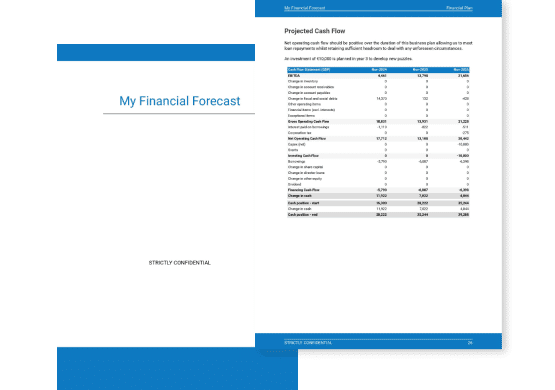
Your financial forecast will also be part of your overall business plan (which we will detail in a later step), which is the document you will need to secure financing.
Financial forecasts are used to drive your panini shop and make key decisions, both in the pre and post-launch phases:
- Should we go ahead with the business or scrap the idea?
- Should we hire staff or use an external service provider?
- Which development project offers the best growth prospects?
- Etc.
Creating a financial forecast for starting a panini shop is an iterative process as you will need to refine your numbers as your business idea matures.
As your panini shop grows, your forecasts will become more accurate. You will also need to test different scenarios to ensure that your business model holds true even if economic conditions deteriorate (lower sales than expected, difficulties in recruiting, sudden cost increases or equipment failure problems, for example).
Once you’ve launched your business, it will also be important to regularly compare your accounting data to your financial projections in order to keep your forecast up-to-date and maintain visibility on future cash flows.
What does a financial projection look like?
Your panini shop forecast will be presented using the following financial tables.
The projected P&L statement
The projected P&L statement for a panini shop shows how much revenue and profits your business is expected to generate in the future.
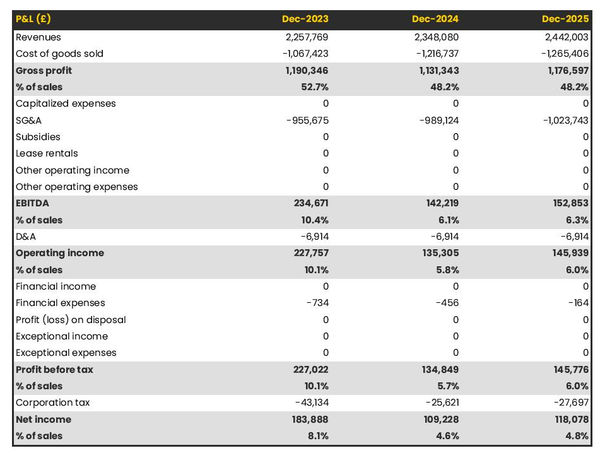
The projected balance sheet of your panini shop
Your panini shop's projected balance sheet provides a snapshot of your business’s financial position at year-end.
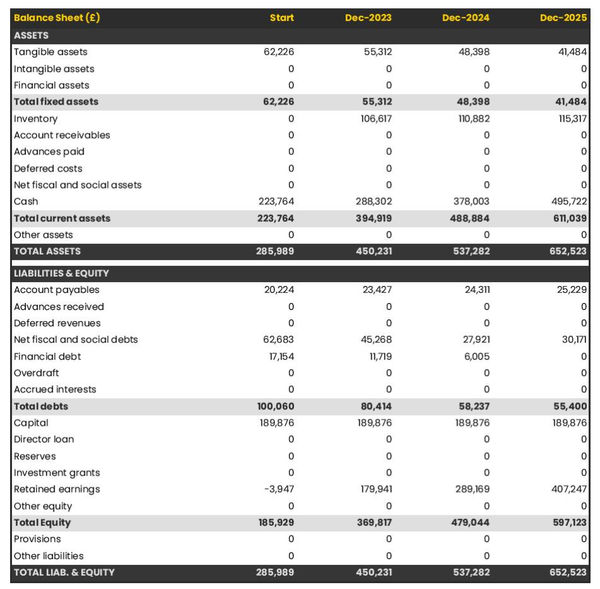
The cash flow forecast
A projected cash flow statement for a panini shop is used to show how much cash the business is expected to consume or generate in the years to come.
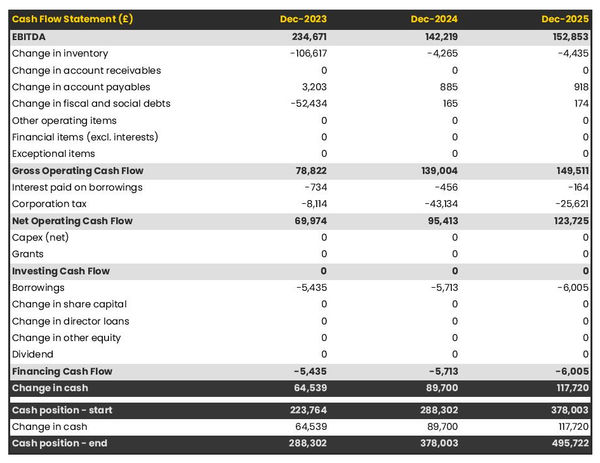
Which solution should you use to make a financial projection for your panini shop?
Using an online financial forecasting tool, such as the one we offer at The Business Plan Shop, is the simplest and safest solution for forecasting your panini shop.
There are several advantages to using specialised software:
- You can easily create your financial forecast by letting the software take care of the financial calculations for you without errors
- You have access to complete financial forecast templates
- You get a complete financial forecast ready to be sent to your bank or investors
- The software helps you identify and correct any inconsistencies in your figures
- You can create scenarios to stress-test your forecast's main assumptions to stress-test the robustness of your business model
- After you start trading, you can easily track your actual financial performance against your financial forecast, and recalibrate your forecast to maintain visibility on your future cash flows
- You have a friendly support team on standby to assist you when you are stuck
If you are interested in this type of solution, you can try our forecasting software for free by signing up here.
How do I choose a name and register my panini shop?
Now that your project of launching a panini shop is starting to take shape, it's time to look at the name of your business.
Finding the name itself is generally fairly easy. The difficulty lies in registering it.
To prevent this guide from being too long, we won't go into all the criteria you need to take into account when choosing a striking name for your panini shop. However, try to choose a name that is short and distinctive.
Once you have a name that you like, you need to check that it is available, because you cannot use a name that is identical or similar to that of a competitor: this type of parasitic behaviour is an act of unfair competition for which you risk being taken to court by your competitors.
To avoid any problems, you will need to check the availability of the name:
- Your country's company register
- With the trademark register
- With a domain name reservation company such as GoDaddy
- On an Internet search engine
If the desired name is available, you can start the registration process.
It is common to want to use the trading name as the name of the company, and to have a domain name and a registered trademark that also correspond to this name: Example ® (trading name protected by a registered trademark), Example LTD (legal name of the company), example.com (domain name used by the company).
The problem is that each of these names has to be registered with a different entity, and each entity has its own deadlines:
- Registering a domain name is immediate
- Registering a trademark usually takes at least 3 months (if your application is accepted)
- The time taken to register a new business depends on the country, but it's generally quite fast
How do I go about it?
Well, you have two choices:
- Complete all registrations at the same time and cross your fingers for a smooth process.
- Make sure to secure the domain names and trademarks. Once that's done, wait for confirmation of a successful trademark registration before moving on to register the company.
At The Business Plan Shop, we believe it's essential to prioritize securing your domain names and trademarks over the business name. This is because you have the flexibility to use a different trading name than your legal business name if needed.
Regardless, we suggest discussing this matter with your lawyer (see below in this guide) before making any decisions.
Deciding upon the corporate identity of your panini shop
The next step in opening a panini shop is to look at your company's visual identity.
Your company's “visual identity” plays a crucial role in shaping your brand image. It helps you to be recognizable and to stand out from your competitors.
Although you can define your visual identity yourself, it is generally advisable to call on the services of a designer or marketing agency to achieve a professional result.
At a minimum, you will need to define the following elements:
- Logo
- Brand guidelines
- Business cards
- Website theme
Logo
Your panini shop's logo allows others to quickly identify your company. It will be used on all your communication media (website, social networks, business cards, etc.) and official documents (invoices, contracts, etc.).
In addition to its design, it's important that your logo is available in a variety of colors, so that it can be seen on all media (white, dark background, etc.).
Brand guidelines
Having brand guidelines enables you to maintain consistency in formatting across all your communications media and official documents.
Brand guidelines define the font (family and size), design and colours used by your brand.
In terms of fonts, for example, you may use Roboto in size 20 for your titles and Lato in size 14 for your texts.
The colours used to represent your brand should generally be limited to five:
- The main colour,
- A secondary colour (the accent),
- A dark background colour (blue or black),
- A grey background colour (to vary from white),
- Possibly another secondary colour.
Business cards
Designing business cards for your panini shop is a must, as they will allow you to communicate your contact details to your customers, suppliers, partners, potential recruits, etc.
In principle, they will include your logo and the brand guidelines that we mentioned above.
Website theme
In the same way, the theme of your panini shop website will be based on your logo and the brand guidelines we mentioned above.
This involves defining the look and feel of your site's main graphic elements:
- Buttons,
- Menus,
- Forms,
- Banners,
- Etc.
What legal steps are needed to start a panini shop?
The next step in opening a panini shop is to look in detail at the legal and regulatory formalities.
Although it is possible to do the formalities yourself and draft some of the documents detailed here, The Business Plan Shop recommends that you seek advice on these aspects from a law firm.
Registering a trademark and protecting the intellectual property of your panini shop
One of the first things you need to do here is to protect your company's current and future intellectual property.
One way of doing this is to register a trade mark, as mentioned earlier in this guide. Your lawyer will be in a position to do the formalities for you and to help you select the classes (economic activities) and jurisdictions in which you have an interest in obtaining protection.
Your law firm can also advise you on other ways of protecting your company's intellectual property.
Preparing the legal documents for your panini shop
Your panini shop will need a set of legal and contractual documents to operate on a daily basis.
Your exact needs in this respect will depend on the country in which you are launching your panini shop and the size and legal form envisaged for the company. Once again, we highly recommend having these documents prepared by your lawyer.
As a minimum, we recommend that you have the following documents prepared:
- Employment contracts
- General terms and conditions of sale
- General terms and conditions of use for your website
- Privacy Policy for your website
- Cookie Policy for your website
- Invoices
- Etc.
Applying for licences and permits and registering for various taxes
Here too, the list of licences and business permits required for your business to operate legally will depend on the country in which you have decided to start your panini shop.
Your law firm will be able to advise you on all the regulations applicable to your business.
Likewise, your accountant will be able to assist you and take care of the formalities involved in complying with the tax authorities.
Writing a business plan for your panini shop
The next step in opening a panini shop is to draw up your business plan.
What is a panini shop's business plan?
A business plan serves as a comprehensive roadmap outlining the objectives, strategies, and key components of your venture.
There are two essential parts to a business plan:
- A numerical part, the financial forecast we mentioned earlier in this guide, which highlights the amount of initial financing needed to launch the business and its potential profitability over the next 3 to 5 years,
- A written part, which presents in detail the project of creating a panini shop and provides the necessary context to enable the reader of the business plan to judge the relevance and coherence of the figures included in the forecast.
Your business plan helps guide decision-making by showcasing your vision and financial potential in a coherent manner.
Your business plan will also be essential when you're looking for financing, as your financial partners will ask you for it when deciding whether or not to finance your project to open a panini shop. So it's best to produce a professional, reliable, and error-free business plan.
In essence, your business plan is the blueprint to turn your idea into a successful reality.
What tool should you use to create your panini shop business plan?
If you want to write a convincing business plan quickly and efficiently, a good solution is to use an online business plan software for business start-ups like the one we offer at The Business Plan Shop.
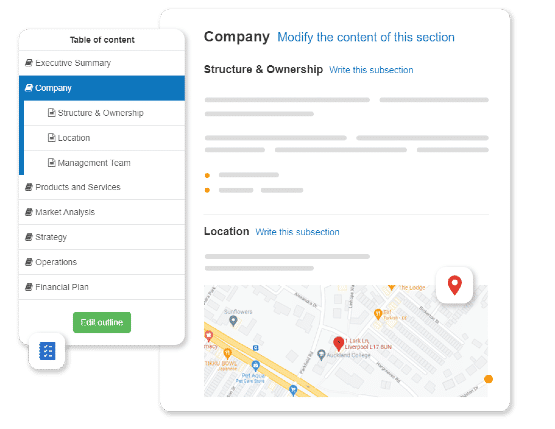
Using The Business Plan Shop to create a business plan for a panini shop has several advantages :
- You can easily create your financial forecast by letting the software take care of the financial calculations for you without errors
- You are guided through the writing process by detailed instructions and examples for each part of the plan
- You can access a library of dozens of complete startup business plan samples and templates for inspiration
- You get a professional business plan, formatted and ready to be sent to your bank or investors
- You can create scenarios to stress test your forecast's main assumptions
- You can easily track your actual financial performance against your financial forecast by importing accounting data
- You can easily update your forecast as time goes by to maintain visibility on future cash flows
- You have a friendly support team on standby to assist you when you are stuck
If you're interested in using our solution, you can try The Business Plan Shop for free by signing up here.
Raise the financing needed to launch your panini shop
With your business plan in hand, you can tackle one of the final steps to open a panini shop business: the search for financing.
Raising the capital needed to launch your business will probably require a combination of equity and debt, which are the two types of financing available to companies.
Equity funding
Equity is the sum of money invested in a panini shop by both founders and investors.
Equity is a key factor in business start-ups. Should the project fail, the sums invested in equity are likely to be lost; these sums therefore enable the founders to send a strong signal to their commercial and financial partners as to their conviction in the project's chances of success.
In terms of return on investment, equity investors can either receive dividends from the company (provided it is profitable) or realize capital gains by selling their shares (provided a buyer is interested in the company).
Equity providers are therefore in a very risky position. They can lose everything in the event of bankruptcy, and will only see a return on their investment if the company is profitable or resold. On the other hand, they can generate a very high return if the project is a success.
Given their position, equity investors look for start-up projects with sufficient growth and profitability potential to offset their risk.
From a technical standpoint, equity includes:
- Share capital and premiums: which represent the amount invested by the shareholders. This capital is considered permanent as it is non-refundable. In return for their investment, shareholders receive shares that entitle them to information, decision-making power (voting in general assembly), and the potential to receive a portion of any dividends distributed by the company.
- Director loans: these are examples of non-permanent capital advanced to the company by the shareholders. This is a more flexible way of injecting some liquidity into your company as you can repay director loans at any time.
- Reserves: these represent the share of profits set aside to strengthen the company's equity. Allocating a percentage of your profits to the reserves can be mandatory in certain cases (legal or statutory requirement depending on the legal form of your company). Once allocated in reserves, these profits can no longer be distributed as dividends.
- Investment grants: which represent any non-refundable amounts received by the company to help it invest in long-term assets.
- Other equity: which includes the equity items which don't fit in the other categories. Mostly convertible or derivative instruments. For a small business, it is likely that you won't have any other equity items.
The main sources of equity are as follows:
- Contributions made by the owners.
- Private investors: business angels, friends and family.
- Crowdfunding: raising funds by involving a group of people through campaigns where they contribute money or make donations, often getting something in return for their support.
- Start-up aid, e.g. government loans to help founders build up their start-up capital.
Debt financing
Debt is the other way of financing companies. Unlike equity, debt offers lenders a limited, contractually guaranteed return on their investment.
Your panini shop undertakes to pay lenders' interest and repay the capital borrowed according to a pre-agreed schedule. Lenders are therefore making money whether or not your company makes a profit.
As a result, the only risk lenders take is that of your panini shop going bankrupt, so they're extremely conservative and will want to see prudent, hands-on management of the company's finances.
From the point of view of the company and all its stakeholders (workforce, customers, suppliers, etc.), the company's contractual obligation to repay lenders increases the risk for all. As a result, there is a certain caution towards companies which are too heavily indebted.
Businesses can borrow debt in two main ways:
- Against assets: this is the most common way of borrowing. The bank funds a percentage of the price of an asset (a vehicle or a building, for example) and takes the asset as collateral. If the business cannot repay the loan, the bank takes the asset and sells it to reduce losses.
- Against cash flows: the bank looks at how much profit and cash flow the business expects to make in the future. Based on these projections, it assigns a credit risk to the business and decides how much the business can borrow and under what terms (amount, interest rate, and duration of the loan).
It's difficult to borrow against future cash flows when you're starting a panini shop, because the business doesn't yet have historical data to reassure about the credibility of cash flow forecast.
Borrowing to finance a portion of equipment purchases is therefore often the only option available to founders. The assets that can be financed with this option must also be easy to resell, in the unfortunate event that the bank is forced to seize them, which could limit your options even further.
As far as possible sources of borrowing are concerned, the main ones here are banks and credit institutions. Bear in mind, however, that each institution is different, in terms of the risk it is prepared to accept, what it is willing to finance, and how the risk of your project will be perceived.
In some countries, it is also possible to borrow from private investors (directly or via crowdfunding platforms) or other companies, but not everywhere.
Key points about financing your panini shop
Multiple solutions are available to help you raise the initial financing you need to open your panini shop. A minimum amount of equity will be needed to give the project credibility, and bank financing can be sought to complete the financing.
Track your actuals against your forecast
You've reached the end of the road and are ready to launch your panini shop.
Congratulations and welcome to the fantastic world of entrepreneurship! Celebrate the work you've done so far, and get back to work quickly, because this is where the real work begins.
Your first priority will be to do everything you can to make your business sustainable (and thus avoid being one of the 50% of start-ups that fail within five years of launching).
Your business plan will be your best ally to ensure that you're on track to achieve your objectives, or to help rectify the situation if necessary.
The key to financial management is to regularly compare your actual accounting data with your panini shop forecasts, in order to be able to :
- Quantify the gaps between what you planned and what you achieved
- Adjust your financial forecasts as the year progresses to maintain visibility over your future cash flow
No one can predict the future with certainty, but by closely monitoring the variances between actuals and forecasts, regularly adjusting your forecasts and simulating several scenarios, you can prepare your panini shop for the worst while hoping for the best.
It's the only way to keep an eye on your cash flow and actively manage the development of your panini shop, ultimately reducing the risk to your company.
There's nothing worse than waiting for your company's annual accounts to close, which can be many months after the end of your financial year (up to nine months in the UK for example), only to realize that you've fallen far short of your forecasts for the past year, and that your panini shop urgently needs a cash injection to keep going.
That's why it's strongly recommended to use a financial planning and analysis solution that integrates forecasting, scenario analysis, and actuals vs. forecast tracking, like we do at The Business Plan Shop with our financial dashboards.
Key takeaways
- To open a panini shop you need to go through each of the 15 steps we have outlined in this guide.
- The financial forecast is the tool that will enable you to check that your project can be profitable and to estimate the investment and initial financing requirements.
- The business plan is the document that your financial partners will ask you to produce when seeking finance.
- Once you have started trading, it will be essential to keep your financial forecasts up to date in order to maintain visibility of the future cash flow of your panini shop.
- Leveraging a financial planning and analysis platform that seamlessly integrates forecasts, business plans, and real-time performance monitoring — like The Business Plan Shop — simplifies the process and mitigates risks associated with launching a business.
We hope this practical guide has given you a better understanding of how to open a panini shop. Please do not hesitate to contact our team if you have any questions or if you would like to share your experience of setting up your own business.
Also on The Business Plan Shop
Do you know someone who is thinking about opening a panini shop? Share our guide with them!
